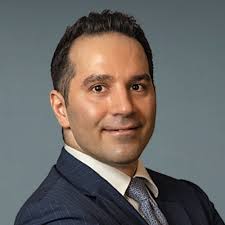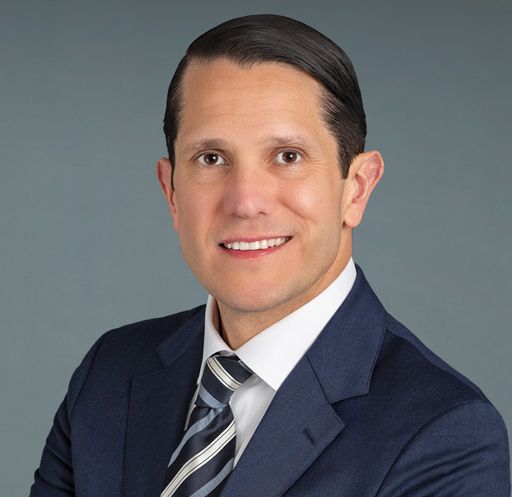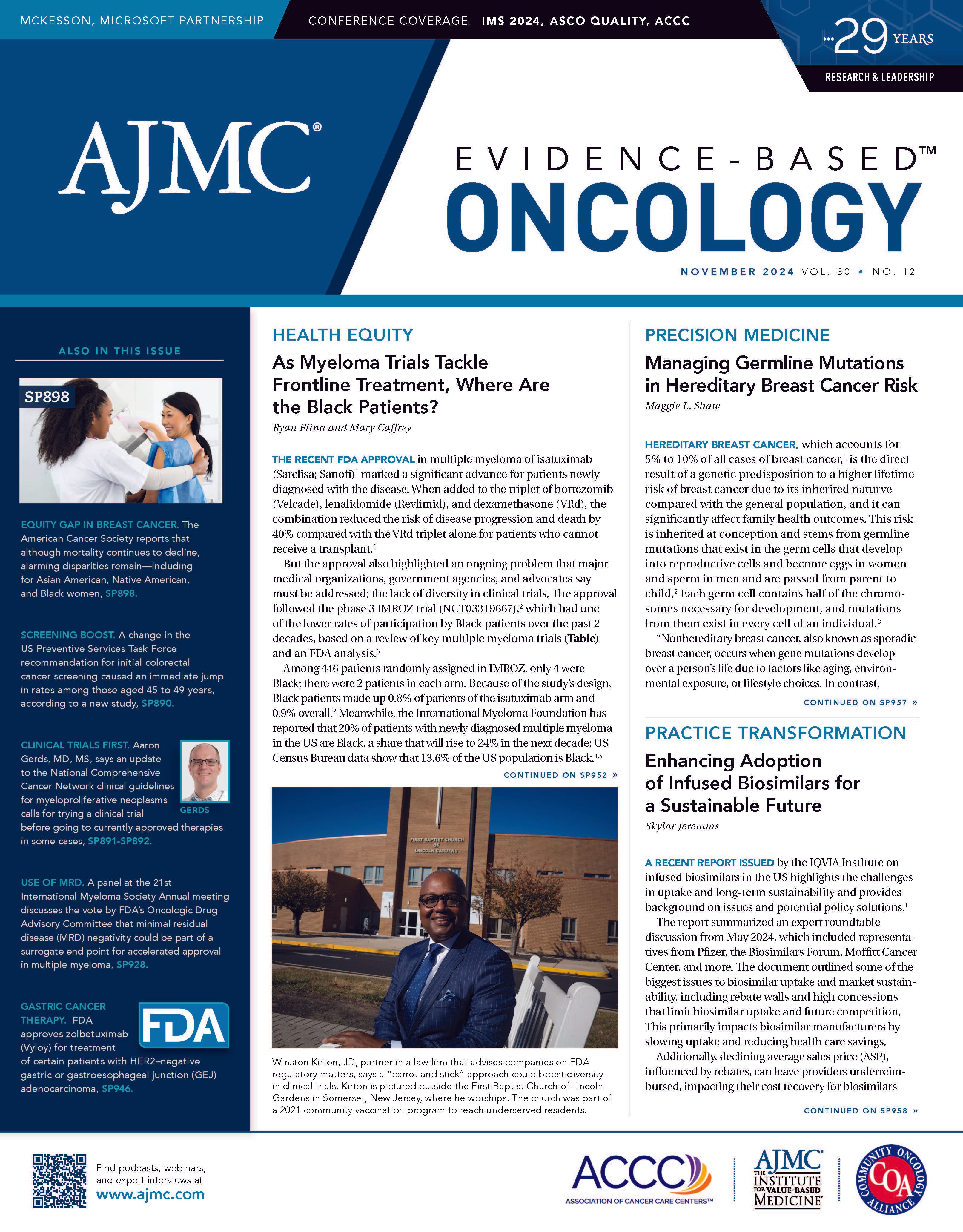- Center on Health Equity & Access
- Clinical
- Health Care Cost
- Health Care Delivery
- Insurance
- Policy
- Technology
- Value-Based Care
Collaborating for Cancer Care Equity: Community and Academic Insights
Coverage from the recent Institute for Value-Based Medicine event with NYU Langone Health.
Experts from top cancer centers and venture capital gathered to share their thoughts and experiences on the theme “Enhancing Community Cancer Programs With Academic Excellence Through Strategic Partnerships” during the October 17, 2024, Institute for Value-Based Medicine® event held by The American Journal of Managed Care in partnership with NYU Langone Health.
Emeline Aviki, MD, MBA, FACOG | Image: NYU Langone Health

Oscar B. Lahoud, MD | Image: NYU Langone Health

Their data-driven discussions examined how to bridge the chasm between community-led cancer care and research that seeks to optimize patient outcomes and strengthen program support Emeline Aviki, MD, MBA, FACOG, medical director of network integration and strategy for NYU Langone Health Perlmutter Cancer Center, cochaired the meeting with Oscar B. Lahoud, MD, section chief of hematology at NYU Langone Hospital-Brooklyn and director for strategy and network operations in the Division of Hematology and Oncology at Perlmutter Cancer Center. Featured panelists were:
- Samyukta Mullangi, MD, MBA, medical director of oncology of Thyme Care and medical oncologist at Tennessee Oncology in Nashville;
- Mario Lacouture, MD, chief of the Division of Dermatology at NYU Grossman Long Island School of Medicine, and medical director of the Symptom Management Program at Perlmutter Cancer Center of NYU Langone Hospital–Long Island; and
- Brita Roy, MD, MPH, clinical associate professor of population health and director of Community Health and Clinical Outcomes at NYU Langone Health.
Their presentations emphasized how policies and political decisions help to shape cancer care, especially in community settings that often face financial and regulatory challenges. The academic-community partnerships at the center of these talks offer transformative initiatives; the speakers discussed multidisciplinary collaboration, data sharing, and patient support that focused on addressing social determinants of health and improving health equity through equitable access, clinical trial diversity, and technology.
“There’s just no question that delivering care closer to home has tremendous benefits. The obstacle is, how do you do that in a way that ensures the highest level of quality and a consistent level of quality across very diverse settings?” Aviki said. “What are the different ways that you can navigate these diverse settings to ensure that patients are receiving the same world-class quality of care no matter where they’re being treated?”
Policy Updates in Cancer Care
Samyukta Mullangi, MD, MBA | Image: Tennessee Oncology

In this election year, potential shifts in health care policies are front and center, and they likely depend on what changes come with the return of Donald Trump as the 47th president of the United States.1 Mullangi highlighted those of maximum interest, including the use of existing vehicles of law and policy, drug pricing, pharmacy benefit manager (PBM) reform, reinterpretation of the Stark Law on physician self-referrals2 and older patients’ access to critical medications,3 physician fee schedules, average sales price (ASP) cuts, 340B reform, and the extension of telemedicine provisions.
“Paying attention is important,” she emphasized. “These policies will have a direct impact on things like consolidation, access, investments, innovation, and how we deliver care to the patients that we serve.”
The future of the Affordable Care Act (ACA) is in question, Mullangi said at the time; with Republicans poised to control both the White House and the Congress at press time, expectations are that the ACA may not be fully overturned but changes are likely. Republicans have historically aimed to limit the ACA’s reach—with research from 2018 showing that most Americans (56% overall; of those polled, 80% were Democrats, 54% Independents, 28% Republicans) think a Trump administration could cause the ACA to fail.4 Mullangi also presented policy options in drug pricing and reproductive health for Trump and for Vice President Kamala Harris, as the event took place before the November 5, 2024, election.5
Another top-of-mind issue is the financial pressure that community oncology practices continue to face through insufficient reimbursement structures, ASP erosion, and drug affordability. In the past, Trump has focused on price transparency and international drug price comparisons. He has not, however, taken a firm stance on Medicare reimbursement or National Institutes of Health funding cuts, knowing that regulatory changes affect community oncologists’ abilities to maintain independent practices.
In contrast, areas of bipartisan support that could advance regardless of the election outcome are PBM reform and Stark. For the former, this could mean requiring greater transparency of rebates and fees regarding drug list prices, and for the latter, continuing to try to strike down the Medicare FAQ provisions that restrict physician delivery of medications via mail order—with the unfortunate consequence of contributing to care disparities for patients who live in rural areas or are disabled.
“To continue to survive and thrive as community oncologists, we need to educate our leaders,” she concluded, “and advocate for responsible choices that continue to drive research innovation and access to improve cancer care.”
Bridging Gaps in Specialty Care
Mario Lacouture, MD | Image: NYU Grossman

Lahoud then introduced Lacouture as a pioneer for helping to transform the field of onco-dermatology, “now formally recognized as a specialty around the world, including with the American Academy of Dermatology and the International Society of Dermatopathology.” Lacouture started his presentation with the necessity of promoting interdisciplinary care within oncology by both highlighting misconceptions about the field from those on the outside looking in and fulfillment from seeing patients battle what is very often a debilitating disease.
“We see this struggle that people face, and we see the courage that people show us on a daily basis as they fight the disease,” Lacouture said, “and they allow us to participate in their care.”
However, cancer care is becoming increasingly complex. Principal modes of treatment include surgery, radiotherapy, cytotoxic chemotherapy, molecularly targeted therapy, and immunotherapy; survivorship is skyrocketing, both in total survivors and those still alive 25 years or more after their initial diagnosis; and more patients are now living with comorbidities that come with age due to the increased survivorship (eg, diabetes, renal disease, obesity, cardiovascular disease, and neurological disorders).6-8
The price these patients pay for their survival, in terms of mild to moderate or severe treatment-related adverse events and symptom management, impact on quality of life, financial burden, and challenges with long-term adherence demonstrate mean that multidisciplinary collaboration among research and community centers and between oncology and other disciplines—the sharing of knowledge—is fast becoming necessary for care to advance and to keep up with the ever-growing patient base.
Specialist access is easier wished for than done, however, Lacouture pointed out, which makes it all the more important to create and implement standard guidelines for patient referrals and management “to ensure consistency in care delivery across different providers and settings and to reduce variability and potential errors in symptom management.” His suggestions include being preoccupied with failure, or actively surveilling for adverse events to manage them sooner; taking a proactive approach to reduce the incidence of adverse effects; deferring to the other care specialists on the team who may have more knowledge on how to best manage a certain adverse effect; making real-time adjustments to treatment based on observed symptoms; and always learning through ongoing research and clinical trials.
These tools of efficiency are at the heart of Perlmutter’s Symptom Management Program and its focus on driving excellence through specialty care, he explained. The programs 3 pillars are as follows:
Optimizing specialist referrals and making that process more straightforward can reduce care fragmentation and increase care coordination and referral tracking, which in turn helps to prioritize urgent cases and shorten appointment wait time.
Providing point-of-care decision support gives oncologists and other interdisciplinary care team specialists the critical data they need to support timely interventions.
Utilizing digital patient monitoring improves communication efficiency with interprofessional consultations so patients can get timely input from specialists without needing to be at appointments in person.
“It’s possible to transform oncology practices through these optimized symptom care pathways if a concerted effort is made to include specialists,” he explained. “It’s important to equip all oncology teams with these data-driven tools to really revolutionize the management of symptoms so that they are an integral component of cancer care.”
Improving Cancer Health Outcomes Through Community-Clinical Partnerships
Brita Roy, MD, MPH | Image: NYU Langone

Roy brought the evening’s presentations to a close with an exploration of the profound impact of community-clinical partnerships on improving cancer care outcomes and recognizing and addressing how health and social factors are interconnected and impact medical care.
“Did you know that your zip code can be more important than your genetic code when it comes to morbidity and mortality, especially in the United States, and that really profound health disparities exist depending on where you live?” she asked. For example, in New York City, she explained, just 6 subway stops separate Murray Hill from East Harlem, but there is a 9-year difference in life expectancy, at 85 years vs 76 years.
A staunch advocate for stronger integration of community resources and clinical care, Roy addressed how place-based health disparities can affect cancer risk and outcomes and how within this there are influences from 2 principal pathways. She explained that both the physical environment (eg, walkability, access to green spaces, nutritious food, educational opportunities, stable housing) and psychosocial stressors (eg, structural racism, low social support, exposure to violence, trauma, chronic stress, lack of safety) can create pronounced health disparities, as well as influence cancer screening rates and prevalence of chronic illness.
This is where community involvement and community-clinical partnerships become integral to fostering holistic support for people with cancer within their communities and augmenting existing clinical strategies to improve health equity by addressing social and clinical needs. Such collaborations can make progress in providing comprehensive care in several ways, she noted.
Getting out into the communities is a necessity, as are utilizing community health workers who are diverse and reflect the neighborhoods. They are better able to provide outreach and education, address concerns, and answer questions about cancer screening, she said. It is also pertinent that health care providers, community organizations, and community health workers operate as a single entity, knowing that closer collaboration improves care outcomes and enhances the ability to provide the comprehensive care that is needed.
However, to be effective in this regard, they must not only network effectively but coordinate, cooperate, and collaborate. Doing these things within the communities facilitates information exchange, the sharing of resources, and more effective patient support; improves health literacy; and serves to address social needs, she added.
Community-clinical partnerships play crucial roles in addressing the complex challenges of cancer care, Roy concluded, and by focusing on social determinants of health and fostering interdisciplinary collaboration, “by forging strong partnerships between clinics and the neighborhoods they serve, we can create lasting change and ensure equitable access to the care and resources everyone deserves. The health of the community is the foundation upon which we must build.”
References
1. Steinzor P. The 2024 presidential election: implications for health care policy. AJMC. October 18, 2024. Accessed October 31, 2024. https://www.ajmc.com/view/the-2024-presidential-election-implications-for-health-care-policy
2. AJMC staff. COA supports bills to ensure access to cancer medications. Am J Manag Care. 2024;29(suppl 8):SP722.
3. McCormick B. House unanimously passes seniors’ access to Critical Medications Act. AJMC. September 25, 2024. Accessed October 31, 2024. https://www.ajmc.com/view/house-unanimously-passes-seniors-access-to-critical-medications-act.
4. A majority of Americans say the Trump administration is trying to make the Affordable Care Act fail. KFF. July 26, 2018. Accessed October 31, 2024. https://www.kff.org/affordable-care-act/slide/a-majority-of-americans-say-the-trump-administration-is-trying-to-make-the-affordable-care-act-fail/
5. Steinzor P. Biden-Harris administration proposes new rule to expand affordable contraception coverage. AJMC. October 23, 2024. Accessed October 31, 2024. https://www.ajmc.com/view/biden-harris-administration-proposes-new-rule-to-expand-affordable-contraception-coverage
6. Panigrahi G, Ambs S. How comorbidities shape cancer biology and survival. Trends Cancer. 2021;7(6):488-495. doi:10.1016/j.trecan.2020.12.010
7. Gallicchio L, Devasia TP, Tonorezos E, Mollica MA, Mariotto AB. Estimation of the number of individuals living with metastatic cancer in the United States. J Natl Cancer Inst. 2022;114(11):1476-1483. doi:10.1093/jnci/djac158
8. Tonorezos E, Devasia TP, Mariotto AB, et al. Prevalence of cancer survivors in the United States. J Natl Cancer Inst. Published online July 13, 2024. doi:10.1093/jnci/djae135

